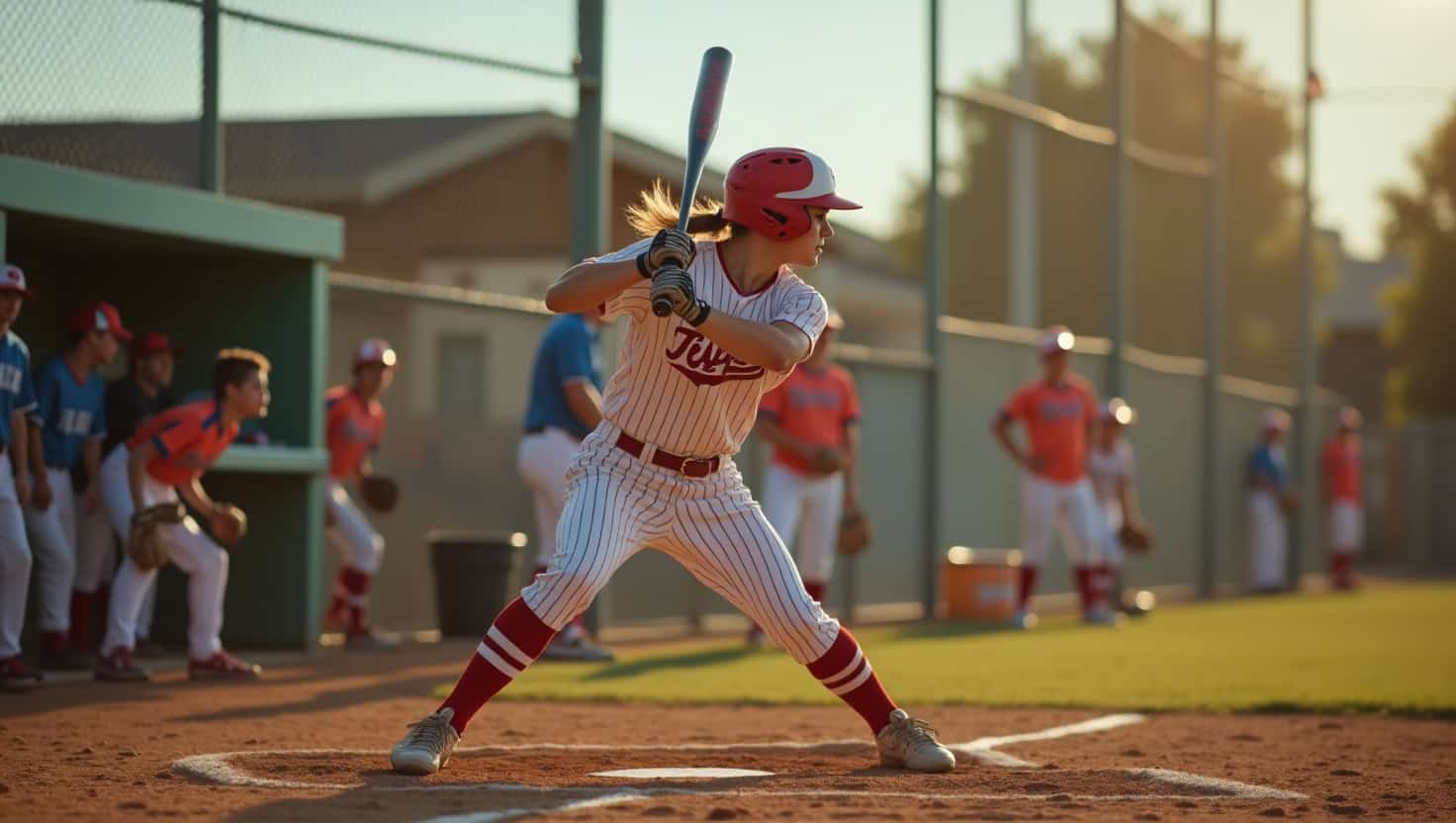Softball Swing Mechanics: 8 Mischievous Tips To Dominate!

Batter up! Are you ready to take your softball game to the next level? Mastering softball swing mechanics is the key to becoming a hitting powerhouse on the field. Having a solid foundation in softball swing mechanics is crucial for success. In this guide, we’ll break down the essential components of a great softball swing, helping you crush those softballs and outsmart even the trickiest pitchers. Let’s dive in and transform your hitting game!
The Importance of Proper Stance and Grip
Let’s talk about getting your softball swing mechanics right from the get-go. I’ve been playing and coaching for 25+ years, and I can’t stress enough how crucial your stance and grip are. It’s like building a house – you gotta have a solid foundation, or the whole thing will come crashing down.
First off, your stance. You want to be balanced and ready to attach the softball. Your feet should be about shoulder-width apart, with a 60/40 weight distribution. I recommend a 60% of your weight leaning on your back leg. You want to feel like you are a coiled spring, ready to unleash all that energy.
Next, keep your knees slightly bent so you can remain balanced. If your feet are too close together it will be easier to be off-balance during your swing. If your feet are too far apart you won’t be able to transfer your weight effectively from back to front during your swing which gives you a ton of power in your swing.
What about the grip? This is where a lot of new players may have it wrong. You want to hold the bat like you’re shaking hands with it, not strangling the life outta it. Your knuckles can be lined up, or slightly offset which ever is most comfortable for you. The key is to not grip the bat too tight but firm enough to maintain control. I’ve seen many new players struggle initially because they are white-knuckling that bat.
Keep in mind: your grip can make or break your swing control. Too loose, and that bat’s gonna be flying out of your hands. Duck!! That was a close one! A flying bat is an easy way to accidentally hurt a fellow player or coach. Too tight, and you’ll struggle with your swing as it restricts your follow through. It’s all about finding that sweet spot not too tight and not too loose.
Remember, practice makes better. Don’t be afraid to experiment a little to find what feels right for you as everyone’s body moves a little different. What might feel great for you might not feel great for someone else. Just keep these basics in mind, and you’ll be on your way to crushing it at the plate.
Mastering the Load and Stride
Alright, let’s chat about the load and stride of a great swing. This is where the magic happens, my friends! It’s like the wind-up before the throw – get this right, and you’re setting yourself up for success.
So, the loading phase. This is when you’re shifting your weight back, the 60/40 rule we talked about earlier. Remember, visualize you are a coiled spring, getting ready to explode forward. It’s subtle, but it’s so important. You’re basically storing up all that potential energy, like a rubber band being stretched. The key here is to keep it smooth and controlled when shifting that weight from the back to the front.
Now, let’s talk about the stride. This is where you’re transferring all that stored energy forward. When shifting the weight forward, your leading foot closest to the pitcher should stride forward a little bit – we’re not taking a huge step forward here. Your front foot should land fairly softly, just like taking a regular step. And here’s a pro tip: try to land with your toes pointing towards home plate closed slightly. It’ll help with hip rotation later on.
Balance is crucial during the stride. I have seen a lot of players over the years swing way too hard and lose their balance and almost falling over. Also keep your head still and your eyes locked on the pitch during your swing and this will dramatically help your balance.
Here’s a drill I love for improving balance during the stride: practice your stride without a bat. Yep, you heard me right. Just focus on the movement, making sure you’re staying balanced throughout. Once you’ve got that down, add the bat back in.
One last thing to bear in mind: your stride length can affect your timing. Too long, and you will struggle with opening your hips to transfer your weight from back to front. Too short, and you won’t get the full benefit of unleashing your pent up energy from back to front. It’s all about finding that Goldilocks zone – not too long, not too short, but juuuust right.
Perfecting Your Softball Swing Mechanics
Now we’re getting to the heart of the matter – the swing itself. This is where all the pieces come together, and it’s a beautiful thing when it all clicks.
Let’s break down the swing path. You want a nice, level swing – no uppercutting here, this isn’t boxing or golf! Think about swinging on a flat plane, like you’re trying to split the ball in half. It’s all about efficiency here. A level swing gives you the best chance of making solid contact.
Now, the all important hip rotation. This is where a lot of the power comes from, my friends! Your hips should start rotating as you begin your swing towards the pitcher, leading the way for your upper body. It’s like a whip effect – the energy transfers from your legs, through your hips, up to your shoulders, and finally into the bat. Get this right, and you’ll be smashing that ball all over the field.
One thing I always remind my players on is keeping your eyes on the ball. I know, I know, you’ve probably heard this a million times. But there’s a reason for that – it works! Your head should stay still, eyes locked on the ball right up until contact. I’ve seen players who start looking at where they want the ball to go before they’ve even hit it. That’s a one-way ticket back to the bench on a poorly hit or big whiff!!
Here’s a little drill I like to use to improve swing mechanics: the tee drill. Set up a tee and focus on making solid contact. Pay attention to where the ball goes – if it’s consistently going to one side or the other, you might need to adjust your swing path.
Remember, good softball swing mechanics aren’t built overnight. It takes practice, patience, and a whole lot of repetition. But stick with it, and I promise you’ll see results. Before you know it, you’ll be the one everyone’s trying to pitch around!
The Follow-Through: Finishing Strong
Who wants to chat about your swings follow-through? I know, I do! Now, I know what you’re thinking – “The ball’s already been hit, why does it matter what happens after?” Well, the follow-through is just as important as any other part of your softball swing mechanics.
A proper follow-through is like the grand finale of a fireworks show – it ties everything together and leaves a lasting impression. Your bat should continue through the hitting zone and finish high, with your hands ending up near your lead shoulder. It’s all about extension, ensuring all the power from your swing is being transferred into the softball.
The thing about the follow-through – is it can tell you a lot about what happened during your swing. If you’re consistently finishing low, chances are you’re dropping your hands during the swing. If your follow-through is all arms and no body, you’re probably not using your lower half effectively.
But here’s where it gets really interesting – a good follow-through can actually affect the trajectory of the ball. It’s about that last split second of contact. A strong, high finish can help get under the ball a bit more, potentially adding some lift to your hits.
Now, I’ve got a great drill for improving your follow-through consistency. It’s called the fence drill. Stand about six inches away from a fence (or a wall if you’re practicing indoors), and take your swing without the bat. Your goal is to complete your swing without hitting the fence. This forces you to stay compact and extend through the ball.
Another tip: try to hold your finish for a second or two after each swing. It might feel a bit awkward at first, but it’ll help you get a feel for what a good follow-through should be like.
Keep in mind, the follow-through isn’t just about looking good (although a nice finish does look pretty sweet). It’s an integral part of your softball swing mechanics that can have a real impact on your hitting performance. So don’t neglect it – finish strong, and watch those hits start piling up!
Timing and Rhythm in Your Swing
Now let’s get into timing and rhythm – the unsung heroes of solid softball swing mechanics. You could have the prettiest swing in the world, but if your timing’s off, you aren’t going to be making solid contact or any contact at all.
Timing is about meeting the ball at the right moment. Too early, and you’re way out in front. Too late, and you’re swinging at air. It’s like dancing – you gotta move with the music, or in this case, the pitch. It isn’t always easy, especially if you are facing a seasoned pitcher who can change the arc and speed of how the softball gets into the strike zone!
Developing a consistent swing rhythm is key to good timing. Your load (coiled spring), stride, and swing should all flow together smoothly. If they are aren’t smooth and kind of jerky you aren’t utilizing the full power available during your swing.
Here’s a drill you can do for working on timing and watching the ball all the way in until contact: the colored ball drill. Get a bunch of different colored balls and have someone toss them to you. Call out the color as you hit it. It forces you to focus on the ball quickly and time your swing accordingly.
Now, let’s talk about adjusting to different pitch speeds. This is where things can get tricky. For faster pitches, you’ll need to start your swing a bit earlier. For slower ones, you might need to wait back a bit. It’s all about reading the pitch and adjusting on the fly.
One thing that can help with this is soft toss drills at varying speeds. Have a partner toss balls to you, mixing up the speed. Focus on making solid contact regardless of how fast or slow the ball is coming in. There isn’t as much of a speed difference between pitches like there is in baseball or fast pitch softball but there still variability a good pitcher can use.
Good timing and rhythm come with practice. Don’t get discouraged if you’re struggling at first. Keep at it, and before you know it, you’ll be in the zone, your softball swing mechanics becoming smooth as butter. Pro-Tip: Going to a batting cage helps a ton with these mechanics due to the consistency of the pitches for your to try different techniques or slight changes in your swing to see how they work.
Mental Aspects of Softball Swing Mechanics
Okay, let’s chat about the mental side of hitting. Softball swing mechanics aren’t just about what your body’s doing – it’s about what’s going on upstairs too.
First things first, confidence is key. You gotta step up to the plate believing you’re gonna crush it. I’ve seen too many players psych themselves out before the pitch is even thrown. Remember, pitcher’s have nerves just like you during at bats.
Visualization is a powerful tool. Before you even step into the batter’s box, take a moment to imagine yourself making solid contact. See the ball flying off your bat. Feel the sweet spot connecting with the pitch. Trust me, it works.
What about focus? When you’re at the plate, the only thing that should exist is you, the ball, and the bat. Everything else – the crowd, the score, your last at-bat – needs to fade away. It’s like tunnel vision, but in a good way.
Here’s a little trick which can help: develop a routine. Maybe it’s adjusting your batting gloves, tapping the plate twice, taking a deep breath. Whatever it is, make it consistent. It’ll help you get into the right headspace every time you step up to bat.
One thing to keep in mind: don’t overthink it. I have seen players get so caught up in trying to remember every little detail of their softball swing mechanics that it throws off their timing or swing becomes jerky. Your body knows what to do – trust your training and let it happen.
And hey, everybody strikes out sometimes. Don’t let one bad at-bat throw you off your game. Short memory, my friends. Learn from it, then let it go.
The mental game is just as important as the physical one when it comes to softball swing mechanics. Get your head right, and your body will follow. Here is another great article on more advanced mental game techniques for you to explore!
Common Softball Swing Mechanics Mistakes to Avoid
Alright, let’s talk about some of the common slip-ups I see in softball swing mechanics. I’ve seen ’em all, and I’m here to help you avoid these pitfalls.
First up, the dreaded “casting” of the bat. This is when your hands move away from your body during the swing, creating a long, loopy path to the ball. It’s a power-killer and a timing-ruiner. Keep those hands in close to your body until you’re ready to explode through the hitting zone.
Another biggie is dropping your back shoulder. I get it, you want to crush that low pitch. But dropping your shoulder throws off your whole swing plane. Keep that back shoulder up, and let the natural angle of your swing handle those low pitches.
Here’s a classic one: stepping away from the plate. That’s when your front foot steps away from the plate during your stride. All you’re doing is robbing yourself of power and making it harder to reach outside pitches.
Now, let’s talk solutions. For casting, try the ‘don’t spill the milk’ drill. Imagine you’re holding a glass of milk in your back elbow. Swing without ‘spilling’ it. For the dropping shoulder issue, practice hitting off a tee placed at various heights. And for stepping away from the plate, try placing a cone or a glove where your front foot should land, and focus on striding towards it.
Video analysis can be a game-changer when it comes to identifying these issues. Sometimes, what feels right doesn’t look right. Have a coach or teammate film your swings, then watch ’em in slow-mo. You might be surprised at what you see.
Recognizing these common mistakes in your softball swing mechanics is the first step to fixing ’em. Don’t get discouraged if you find yourself making these errors – we all do sometimes. The key is to keep working at it, stay patient, and trust the process.
Advanced Softball Swing Mechanics Techniques
Alright, heavy hitters, who wants some advanced softball swing mechanics? These are the techniques that can take your game from good to great, so listen up!
First, let’s talk about the inside-out swing. This is a fantastic technique for handling inside pitches or for shooting the ball to the opposite field. The key here is to lead with your hands, almost like you’re throwing a punch. It’s all about quick hands and a short, compact swing.
Now, onto situational hitting. Maybe you need to move a runner over, or you’re facing a defensive shift where they are standing where you usually hit. Your swing might need to adjust. For example, to hit behind a runner, you might want to delay your swing slightly to let the ball travel deeper if you are a right handed batter or pull the ball for a lefty.
One advanced drill I love is the heavy bat drill. Take some swings with a bat weight that makes the bat a bit heavier than your game bat. You can also do this by holding multiple bats at one time. When you switch back to your regular bat, your swing will feel lightning-fast.
These advanced softball swing mechanics take time to master. Don’t get frustrated if they don’t click right away. Keep practicing, stay focused, and before you know it, you’ll be the hitter that pitchers fear facing.
And hey, even as you’re working on these advanced techniques, don’t forget the basics. A solid foundation in the fundamentals of softball swing mechanics will always serve you well, no matter how advanced you get. Keep swinging, keep learning, and most importantly, keep having fun out there!
There you have it, softball superstars! We’ve covered the essential softball swing mechanics that’ll have you hitting like a pro in no time. Perfecting your swing is a journey, not a destination. Keep practicing these techniques, and you’ll see improvements in your power, accuracy, and consistency at the plate. Don’t forget to record your swings and analyze them regularly – it’s the best way to track your progress and identify areas for improvement. Now, grab your bat and get out there! The diamond is calling, and it’s time to show off your newly refined softball swing mechanics. Play ball!
Craving more softball wisdom? Unlock game-changing tips below!






